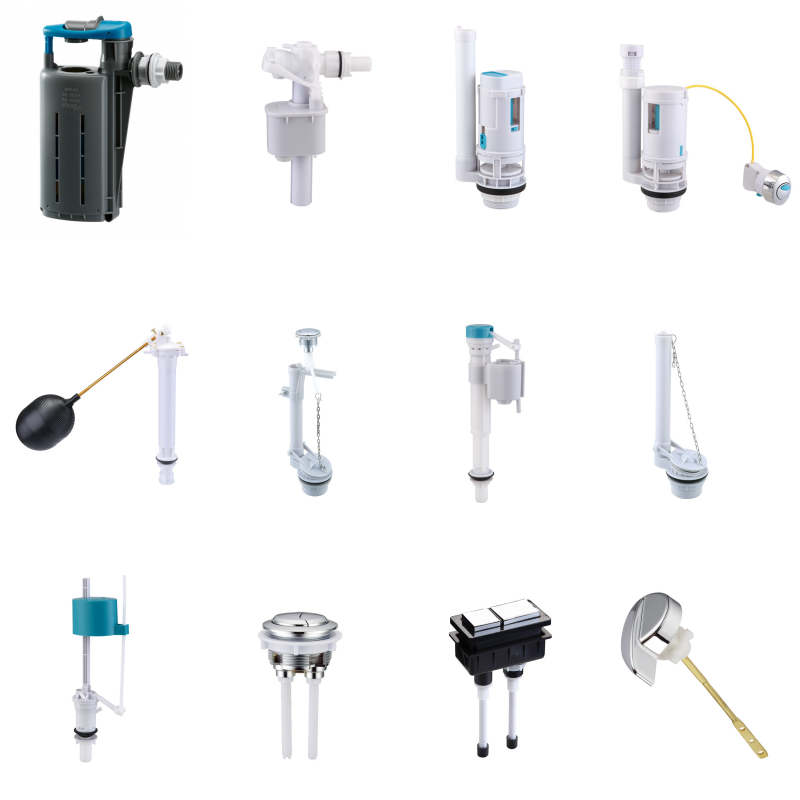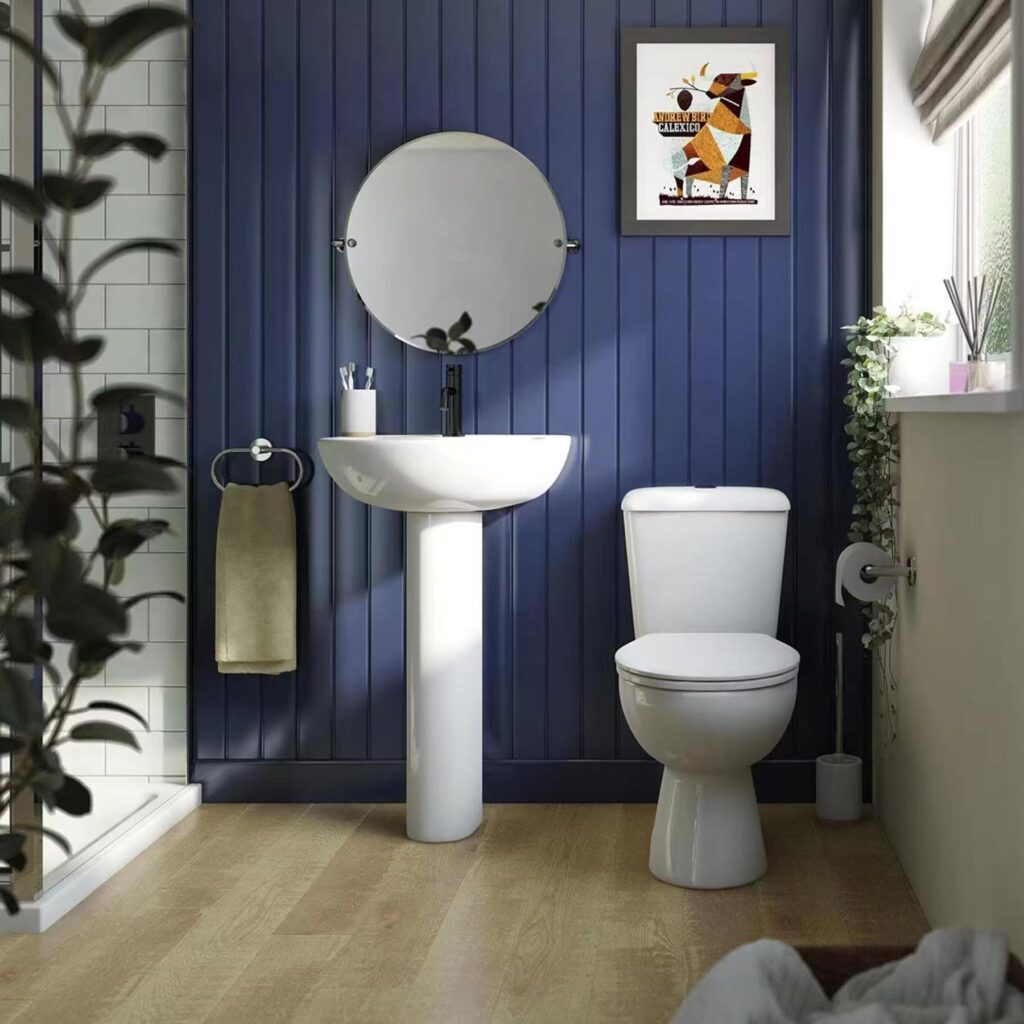מָבוֹא
בנוף הבנייה התחרותי של ימינו, פרויקטים של בנייה ירוקה מתמודדים עם אתגר קריטי: עמידה בסטנדרטים סביבתיים מחמירים מבלי להתפשר על איכות או יעילות. עבור מפתחים, יועצים ויוזמות ממשלתיות, בחירת הגופי הנכונים יכולים לבצע או לשבור יעדי הקיימות של הפרויקט - ואת השורה התחתונה שלו.
הזן שירותים קרמיים ידידותיים לסביבה. אביזרי חדשניים אלה אינם נוגעים רק לשימור מים; הם נכס אסטרטגי בבניין ירוק. עם הפוטנציאל לחתוך את השימוש במים בעד 50% ולהגביר את הצעות הפרויקט ב -15%, הם הופכים את האופן בו אנו ניגשים לבנייה בר -קיימא. אבל עם מספר עצום של אפשרויות זמינות, ממערכות סומק כפול לשירותים חכמים, איך אתה בוחר את שירותי הקרמיקה הידידותיים לסביבה, לפרויקט שלך?
מדריך זה צולל עמוק בעולם הכלים הסניטריים בר -קיימא, ובוחן כיצד אלה שירותים קרמיים ידידותיים לסביבה יכול לעזור לך לעמוד בדרישות הסמכת CE, להפחית את עלויות השירות לטווח הארוך ולהציג את המחויבות שלך לאחריות חברתית תאגידית. בין אם אתה מפתח מנוסה או יועץ המייעץ ביוזמות ירוקות, תמצא תובנות ניתנות לפעולה כדי להעלות את פרויקט הבנייה בר -קיימא הבא שלך.
מדוע שירותים קרמיים ידידותיים לסביבה חשובים לבנייה ירוקה
בעולם הבנייה בת -קיימא, כל רכיב ממלא תפקיד מכריע בהשגת יעדים סביבתיים. שירותים קרמיים ידידותיים לסביבה התגלו כשחקן מפתח במהפכה ירוקה זו, ומציעים תערובת מושלמת של פונקציונליות, אסתטיקה וקיימות. כשאנחנו מתעמקים בחשיבותם של אביזרים אלה, ברור שהם יותר מסתם הכרח בשירותים - הם אבן יסוד של נוהלי בנייה מודרניים ואחראיים.
“שירותים קרמיים ידידותיים לסביבה הם חיוניים לפרויקטים של בנייה ירוקה, ומפחיתים את השימוש במים והשפעה סביבתית תוך עמידה בתקני קיימות מחמירים.”
הגדרת שירותים ידידותיים לסביבה: חומרים וטכנולוגיות
מה מבדיל שירותים קרמיים ידידותיים לסביבה למקביליו המקובלים? זהו שילוב של חומרים חדשניים וטכנולוגיות מתקדמות. שירותים אלה מעוצבים מקרמיקה שמקורם בר -קיימא או ממוחזרים, ומפחיתה את הביקוש למשאבים בתולים. אבל הקסם האמיתי טמון ביכולות חיסכון במים שלהם.
שירותים קרמיים מודרניים ידידותיים לסביבה משתמשים במערכות שטיפה מתקדמות שחתכו באופן דרמטי את צריכת המים. מנגנוני סומק כפול, למשל, מאפשרים למשתמשים לבחור בין סומק מלא או חלקי, תלוי בצורך. דגמים מסוימים מתרחשים עוד יותר, ומשלבים טכנולוגיה בעזרת לחץ המבטיחה סומק חזק עם שימוש מינימלי במים.
מאפיין מפתח נוסף הוא הזיגוג המשמש בשירותים אלה. זיגוגות באיכות גבוהה ולא נקבובית לא רק משפרות את המראה של השירותים, אלא גם מקלים על הניקוי, צמצום הצורך בכימיקלים קשים ושמירת מים במהלך התחזוקה.
התאמה עם תקני בנייה ירוקים ותעודות
עבור מפתחים ובונים, שילוב שירותים קרמיים ידידותיים לסביבה בפרויקטים שלהם הוא יותר מסתם “נחמד שיש” - לעתים קרובות זה הכרח לעמוד בתקני הבנייה הירוקים והסמכות. אפשרויות שירותים בר -קיימא אלה ממלאות תפקיד משמעותי בהשגת נקודות עבור אישורים יוקרתיים כמו LEED (מנהיגות בעיצוב אנרגיה וסביבה), BREEAM (שיטת הערכה סביבתית למוסד המחקר) ותקני בנייה ירוקים אחרים.
על ידי בחירת שירותים מוסמכים CE, כמו אלה שמציעים MFBath, מפתחים יכולים לייעל את תהליך הציות שלהם. זֶה “חותם האישור” מבטיח שהמוצרים עומדים בסטנדרטים אירופיים קפדניים לביצועים איכותיים וסביבתיים, מה שמקל על עמידה בדרישות ההסמכה.
יתרונות למפתחים: CSR והצעות מחיר תחרותיות
היתרונות של שימוש בשירותים בר -קיימא נרחבים מעבר ליתרונות הסביבתיים. עבור מפתחים, אביזרים אלה מייצגים מחויבות מוחשית לאחריות חברתית תאגידית (CSR). בעידן בו הצרכנים והמשקיעים כאחד מודעים יותר ויותר לנושאים סביבתיים, הצגת מסירות לקיימות יכולה לשפר משמעותית את המוניטין של החברה ואת הערעור השוק.
יתר על כן, שילוב שירותים קרמיים ידידותיים לסביבה יכול להעניק למפתחים יתרון תחרותי בתהליכי הצעות מחיר. פרויקטים רבים במגזר הציבורי והפרטי מתעדפים כעת קיימות בקריטריוני הבחירה שלהם. על ידי הפגנת מחויבות לשימור מים ודיילות סביבתית באמצעות שימוש בשירותים אלה, מפתחים יכולים להגדיל את סיכוייהם לזכות בהצעות מחיר בעד 15%.
השפעה סביבתית: הפחתת טביעות רגל פחמן
היתרונות הסביבתיים של שירותים קרמיים ידידותיים לסביבה הם מרחיקי לכת. על ידי צמצום משמעותי של צריכת המים, אביזרים אלה ממלאים תפקיד מכריע בשימור אחד מהמשאבים היקרים ביותר של כדור הארץ שלנו. חיסכון במים זה מתורגם ישירות לצריכת אנרגיה מופחתת לטיפול והפצת מים, מה שמוביל לטביעת רגל פחמן נמוכה יותר לבניינים.
| סוג שירותים | שימוש במים ממוצע לכל סומק (ליטר) | חיסכון שנתי במים (ליטר)* | הפחתת פליטות CO2 (ק"ג לשנה) ** | נקודות LEED פוטנציאליות |
|---|---|---|---|---|
| שירותים סטנדרטיים | 6-13 | 0 | 0 | 0 |
| שירותים נמוכים בזרימה | 4.8 | 16,425 | 6.57 | 1-2 |
| שירותים כפולים | 3-4.5 | 24,637 | 9.85 | 2-3 |
| אסלה יעילות גבוהה במיוחד | 0.8-3 | 32,850 | 13.14 | 3-4 |
| MFBATH CERAMIC ידידותי לסביבה | 2.6-3.8 | 28,470 | 11.39 | 2-3 |
* בהתבסס על שימוש במשק הבית הממוצע של 5 סומק לאדם ליום, 4 אנשים משק בית ** על בסיס פליטות CO2 ממוצעות של 0.4 ק"ג לכל 1000 ליטר מים
לסיכום, שירותים קרמיים ידידותיים לסביבה הם יותר מסתם מגמה-הם מהווים מרכיב מכריע בפרקטיקות בנייה בר-קיימא. על ידי הצעת חיסכון משמעותי במים, התאמה עם תקני בנייה ירוקים, ומתן יתרונות מוחשיים למפתחים, אביזרים אלה מסללים את הדרך לעתיד אחראי יותר לסביבה בבנייה.

מאפייני מפתח של שירותים קרמיים ידידותיים לסביבה
ככל שפרקטיקות בנייה ירוקה משיגות מתיחה ברחבי העולם, אור הזרקורים נופל יותר ויותר על שירותים קרמיים ידידותיים לסביבה. אביזרי חדשניים אלה אינם נוגעים רק לשימור מים; הם מייצגים גישה הוליסטית לקיימות בעיצוב אמבטיה. בואו נצלול לתכונות המפתח שהופכות את השירותים הללו לבחירה בולטת לפרויקטים מודעים לסביבה.
“שירותים קרמיים ידידותיים לסביבה משלבים טכנולוגיות חיסכון במים מתקדמות עם שיטות ייצור בר-קיימא, ומציעות פיתרון מקיף ליוזמות לבנייה ירוקה.”
מערכות זרימה כפולה וזרימה נמוכה: איך הם עובדים
בלב כל שירותים קרמיים ידידותיים לסביבה נמצא מנגנון חיסכון במים שלו. מערכות פלאש כפול מובילות את החבילה, ומציעות למשתמשים את הבחירה בין סומק מלא לפסולת מוצקה לבין סומק מופחת לנוזלים. תכונה פשוטה אך יעילה זו יכולה לחתוך את השימוש במים בעד 67% בהשוואה לשירותים מסורתיים.
מערכות זרימה נמוכה לוקחות שימור מים צעד נוסף קדימה. שירותים אלה משתמשים בטכנולוגיית עיצוב וחסידות לחץ חדשניות כדי ליצור סומק רב עוצמה עם מינימום מים. דגמים מסוימים משתמשים עד 0.8 ליטרים לסומק, רחוק מ -3.5 הגלונים המשמשים שירותים ישנים.
תהליכי ייצור קרמיקה עם פליטה נמוכה
ידידותיות הסביבה של השירותים הללו משתרעת מעבר לשימושם. יצרנים רבים, כולל MFBATH, אימצו תהליכי ייצור קרמיקה עם פליטה נמוכה. שיטות אלה מצמצמות את טביעת הרגל הפחמית של ייצור האסלה על ידי אופטימיזציה של טכניקות ירי כבשן ושימוש בחומרים ממוחזרים בתערובת הקרמיקה.
כַּמָה “קצה קצה” היצרנים אפילו משלבים מוצרי פסולת מתעשיות אחרות בתערובות הקרמיקה שלהם, מה שמפחית עוד יותר את ההשפעה הסביבתית. גישה זו לא רק שומרת על חומרי גלם אלא גם מפנה פסולת ממזבלות.
אפשרויות שירותים חכמות: אוטומציה ויעילות
נישואי הטכנולוגיה והקיימות הולידו אפשרויות שירותים חכמות. השירותים הקרמיים הידידותיים להיי-טק ידידותיים לסביבה לוקחים יעילות לשלב הבא. התכונות יכולות לכלול:
- מערכות שטיפה אוטומטיות המשתמשות בחיישנים כדי לקבוע את נפח הסומק המתאים
- מנגנונים לניקוי עצמי שמפחיתים את הצורך במנקים כימיים קשים
- מערכות גילוי דליפות למניעת פסולת מים
- מעקב אחר שימוש כדי לעזור למשתמשים לפקח ולייעל את צריכת המים שלהם
אמנם תכונות אלה עשויות להיראות מפוארות, אך הן משמשות תפקיד מכריע במקסום יעילות המים ומזעור ההשפעה הסביבתית.
עמידות ותחזוקה לשימוש לטווח הארוך
היבט של קיימות לעיתים קרובות הוא אורך חיים הוא אריכות ימים. שירותים קרמיים ידידותיים לסביבה מעוצבים עם עמידות בראש, לעיתים קרובות בעשורים שנמשכים בטיפול נאות. אריכות ימים זו מצמצמת את הצורך בהחלפות, ובכך שומר על משאבים ומפחית פסולת.
תחזוקת השירותים הללו היא בדרך כלל פשוטה, עם דגמים רבים הכוללים משטחים קלים נקייה המתנגדים להכתים וצמיחת חיידקים. זה לא רק מרחיב את חיי השירותים אלא גם מצמצם את הצורך בכימיקלים לניקוי קשים, ותומך עוד יותר ביעדים סביבתיים.
| תכונה | חיסכון במים (%) | חיסכון באנרגיה (%) | אורך חיים (שנים) | תדר תחזוקה |
|---|---|---|---|---|
| מערכת סליפה כפולה | 50-67 | 30-40 | 20-30 | שְׁנָתִי |
| מערכת זרימה נמוכה | 60-80 | 40-50 | 25-35 | דו שנתי |
| שירותים חכמים | 70-85 | 50-60 | 15-25 | רִבעוֹן |
| ידידותי לסביבה רגילה | 40-60 | 20-30 | 20-30 | שְׁנָתִי |
| דגם ידידותי לסביבה של MFBATH | 55-75 | 35-45 | 25-35 | שְׁנָתִי |
בבחירת שירותים ידידותיים לסביבה, קחו בחשבון את הצרכים הספציפיים והמטרות הסביבתיות שלכם. MFBATH מציע מגוון דגמים הניתנים להתאמה אישית כדי לעמוד בדרישות הפרויקט המגוונות תוך שמירה על תקני קיימות גבוהים. משירותים בסיסיים לחיסכון במים ועד דגמים חכמים מתקדמים, יש שירותים קרמיים ידידותיים לסביבה להתאים לכל פרויקט בנייה ירוק.
לסיכום, שירותים קרמיים ידידותיים לסביבה מייצגים קפיצת מדרגה משמעותית בקיימות האמבטיה. על ידי שילוב של טכנולוגיות חיסכון במים, שיטות ייצור בר-קיימא, תכונות חכמות ועיצוב עמיד, שירותים אלה מציעים פיתרון מקיף לבונים ובעלי בתים מודעים לסביבה כאחד.

השוואה בין דגמי שירותים קרמיים ידידותיים לסביבה
כשמדובר בבחירת השירותים הקרמיים הידידותיים לסביבה הטובים ביותר לבתים וחללים מסחריים, האפשרויות יכולות להיות מכריעות. ניתוח השוואתי זה נועד לפשט את תהליך קבלת ההחלטות שלך על ידי פירוק התכונות והיתרונות של אפשרויות שירותים בר-קיימא מובילות. אנו נחקור את היתרונות והחסרונות של עיצובים שונים ונצלול לדגמים ספציפיים שעושים גלים בעולם שימור המים.
“בחירת שירותים קרמיים ידידותיים לסביבה נכונה יכולה להשפיע באופן משמעותי על מאמצי שימור המים תוך עמידה בתקני בנייה קפדניים וצרכי נוחות משתמשים.”
חתיכה אחת לעומת שירותים דו חלקים: יתרונות וחסרונות
לפני שאנחנו מתעמקים במודלים ספציפיים, חשוב להבין את ההבדל הבסיסי בין שירותים קרמיים ידידותיים לסביבה של חלקים ושני חלקיםו לכל עיצוב היתרונות הייחודיים שלו:
| תכונה | שירותים מקשה אחת | שירותים דו חלקים | יעילות מים | מורכבות התקנה |
|---|---|---|---|---|
| לְעַצֵב | מלוטש, משולב | טנק וקערה נפרדים | דוֹמֶה | מקשה אחת קלה יותר |
| ניקוי | קל יותר לניקוי | נקיקים נוספים | N/a | N/a |
| עֲלוּת | בדרך כלל גבוה יותר | יותר זול | N/a | N/a |
| מִשׁקָל | כבד יותר | קל יותר, קל יותר להובלה | N/a | קל יותר לשני חלקים |
| תיקונים | עשוי לדרוש החלפה מלאה | חלקים הניתנים להחלפה בקלות | N/a | שני חלקים פשוטים יותר |
EGO TB352: פירוט יעילות סומק יחיד
EAGO TB352 הוא א “בולט” שירותים קרמיים ידידותיים לסביבה יחידה סומק שזכה לפופולריות. הנה הסיבה:
- שימוש במים: 1.28 ליטרים לסומק, עמידה בקריטריוני EPA WaterSense
- עיצוב: בנייה מקשה אחת לניקוי קל
- כוח שטיפה: שסתום סומק בגודל 3 אינץ 'לביצועים משופרים
- נוחות: קערה מוארכת ומושב קרן רכה
בעוד שדגמי סומק בודדים כמו TB352 פשוטים יותר לשימוש, הם עשויים שלא להציע פוטנציאל חיסכון במים כמו אפשרויות סומק כפול בתרחישים מסוימים.
EAGO TB346 ו- TB353: חידושים סומק כפול
שירותים סומק כפול מציעים גמישות רבה יותר בשימוש במים. בואו נשווה שני דגמי EAGO פופולריים:
| תכונה | EGO TB346 | EGO TB353 | חיסכון במים (%) | טווח מחירים ($) |
|---|---|---|---|---|
| אפשרויות סומק | 0.8/1.6 GPF | 1.1/1.6 GPF | TB346: 20-25% TB353: 15-20% |
300-400 |
| לְעַצֵב | מקשה אחת | שני חלקים | N/a | TB346: גבוה יותר TB353: נמוך יותר |
| צורת קערה | מוארך | עִגוּל | N/a | N/a |
| הסמכה | Watersense | Watersense | שניהם עומדים בסטנדרטים | N/a |
| תכונות מיוחדות | מושב רך-קרן | ADA תואמת | N/a | משתנה לפי קמעונאי |
דגמי MFBath: התאמה אישית ותאימות
בעוד שאגו מציע אפשרויות מצוינות מחוץ למדף, MFBath מתמחה בפתרונות שירותים קרמיים ידידותיים לסביבה הניתנים להתאמה אישית. הטווח שלהם כולל:
- דגמים מקשה אחת ושני חלקים
- טכנולוגיות סומק שונות (אפשרויות יחיד, כפול וחכם)
- עיצובים הניתנים להתאמה אישית כך שיתאימו לאסתטיקה ספציפית לפרויקט
- כל הדגמים CE מוסמכים לתאימות לשוק האירופי

למפרט מפורט על אפשרויות האסלה הידידותיות לסביבה של MFBATH, יועצים ומומחי רכש יכולים לבקר בהם דף מוצרו משאב זה אינו יסולא בפז לבחירת גופי תואם העומדים הן ביעדי הקיימות והן בדרישות הספציפיות לפרויקט.
לסיכום, בבחירת השירותים הקרמיים הידידותיים לסביבה הטובים ביותר לבתים או פרויקטים מסחריים, קחו בחשבון את הצרכים הספציפיים של החלל, יעדים לחיסכון במים ותחזוקה לטווח הארוך. בין אם לבחור בעיצוב מקשה אחת מלוטשת כמו EAGO TB352, מערכת סומק כפולה רב-תכליתית כמו TB346 או TB353, או פיתרון מותאם אישית מ- MFBATH, אפשרויות האסלה הקיימות של ימינו מציעות שימור מים מרשים מבלי להתפשר על ביצועים או סגנון.

יתרונות פיננסיים ותפעוליים של שירותים בר קיימא
כאשר ענף הבנייה מסתובב לקיימות, שירותים קרמיים ידידותיים לסביבה התגלו כשחקן מפתח בתרגילי בנייה ירוקה. מעבר להשפעתם הסביבתית, אביזרי חדשניים אלה מציעים יתרונות פיננסיים ותפעוליים משמעותיים לבעלי בניין ודיירים כאחד. בואו נחקור כיצד פתרונות קיימא אלה יכולים להשפיע לטובה על השורה התחתונה שלך ולייעל את פעולות הבנייה.
“שירותים קרמיים ידידותיים לסביבה לא רק שומרים על מים אלא גם מספקים חיסכון משמעותי בעלויות ויעילות תפעולית לבעלי בניין ומנהלים.”
חיסכון בחשבון מים: עד 50% הפחתה
אחד היתרונות המיידיים והמוחשיים ביותר של התקנת שירותים לחיסכון במים הוא הפחתה הדרמטית בחשבונות המים. שירותים מסורתיים יכולים להשתמש עד 6 ליטרים לכל סומק, ואילו דגמים מודרניים ידידותיים לסביבה משתמשים עד 1.28 גלונים או פחות. יעילות זו יכולה לתרגם לחיסכון בחשבון מים של עד 50% במקרים רבים.
עבור מבנים מסחריים גדולים או מתחמי מגורים, חיסכון זה יכול להיות משמעותי. בואו נפרק את החיסכון הפוטנציאלי:
| סוג בנייה | שימוש במים שנתי (גלונים) | עלות שירותים מסורתית | עלות שירותים ידידותית לסביבה | חיסכון שנתי |
|---|---|---|---|---|
| משרד קטן (50 עובדים) | 146,000 | 1,460 דולר | 730 דולר | 730 דולר |
| מתחם דירות בינוני (100 יחידות) | 1,825,000 | 18,250 דולר | 9,125 דולר | 9,125 דולר |
| מלון גדול (200 חדרים) | 5,475,000 | 54,750 דולר | 27,375 דולר | 27,375 דולר |
| קניון | 7,300,000 | 73,000 $ | 36,500 דולר | 36,500 דולר |
| מתחם בניית ממשלה | 3,650,000 | 36,500 דולר | 18,250 דולר | 18,250 דולר |
*חישובים המבוססים על שיעורי מים ממוצעים ודפוסי שימוש. החיסכון בפועל עשוי להשתנות.
ROI לטווח הארוך באמצעות חומרים עמידים
היתרונות של שימוש בשירותים בר -קיימא נמשכים מעבר לחיסכון מיידי במים. שירותים קרמיים ידידותיים לסביבה נבנים לרוב עם חומרים באיכות גבוהה יותר ועיצובים חזקים יותר, מה שמוביל לעמידות מוגברת ואורך חיים. זה מתורגם פחות מחליפים ותיקונים לאורך זמן, ומציע תשואה חזקה על ההשקעה (ROI).
לדוגמה, השירותים הקרמיים של MFBATH עם פליטה נמוכה נועדו לעמוד בשימוש כבד במסגרות מסחריות, שעלולות להיות ארוכות 20-30% יותר מהדגמים הסטנדרטיים. במהלך מחזור החיים של הבניין, עמידות זו יכולה לגרום לחיסכון משמעותי בעלויות בתחזוקה והחלפה.
ייעול ביקורת שימוש במים עם גופי מוסמך
עבור בעלי בניין ומנהלים, ביקורת שימוש במים הם חלק מהותי בפיקוח תפעולי. שירותים קרמיים ידידותיים לסביבה, במיוחד אלה עם אישורים כמו WaterSense או CE, מפשטים תהליך זה. אישורים אלה מספקים מדדים סטנדרטיים ליעילות מים, מה שמקל על המעקב והדיווח על שימוש במים.
תהליך ביקורת יעיל זה מועיל במיוחד לפרויקטים ממשלתיים ובניינים המחפשים אישורים ירוקים. השירותים המאושרים על ידי CE של MFBATH, למשל, מציעים א “סוֹהֵר” פיתרון לעמידה בסטנדרטים סביבתיים שונים, עלול לחסוך זמן ומשאבים בתהליך ההסמכה.
שיפור שביעות רצון הדיירים מעיצובים מודרניים
אמנם היתרונות הכספיים ברורים, אך חשוב לא להתעלם מההשפעה על שביעות רצון הדיירים. שירותים קרמיים מודרניים ידידותיים לסביבה כוללים לעתים קרובות עיצובים מלוטשים ופונקציות מתקדמות שיכולות לשפר את חווית המשתמש הכוללת. זה יכול להוות גורם משמעותי בשמירה על הדיירים ולמשוך לקוחות או תושבים מודעים לסביבה.
מאפיינים כמו אפשרויות סומק כפול, פעולה שקטה ומשטחים קלים לנקים לא רק תורמים לחיסכון במים, אלא גם לשפר את החוויה היומיומית של דיירי בניין. עבור מרחבים מסחריים זה יכול לתרגם לשביעות רצון ופריון עובדים גבוהים יותר. בהגדרות מגורים, זו יכולה להיות נקודת מכירה עבור שוכרים או קונים מודעים לסביבה.
לסיכום, הפיננסי והתפעול היתרונות של שירותים קרמיים ידידותיים לסביבה הפוך אותם לבחירה חכמה עבור כל פרויקט בנייה. מחיסכון משמעותי בחשבונות מים לתהליכי תאימות מפושטים ושביעות רצון הדיירים המשופרים, אביזרי בר -קיימא מציעים פיתרון מקיף לניהול בניין מודרני ויעיל. כשאנחנו מתקדמים לעתיד בר-קיימא יותר, השקעה בשירותים לחיסכון במים אינה רק החלטה סביבתית-זו אסטרטגיה עסקית תקינה.

כיצד לבחור את השירותים הקרמיים הידידותיים לסביבה
בחירת שירותים קרמיים מושלמים ידידותיים לסביבה לפרויקט הבניין הירוק שלך יכולה להיות משימה מפחידה. עם מספר אפשרויות שירותים בר -קיימא זמינות, חשוב מאוד לקבל החלטה מושכלת המתאימה ליעדי הפרויקט, התקציב והסטנדרטים הסביבתיים שלך. מדריך זה יעבור אתכם בשיקולי המפתח כדי להבטיח שתבחרו בשירותים חסכוני מים העומדים בכל הדרישות שלכם.
“בחירת שירותים קרמיים ידידותיים לסביבה נכונה כוללת בקפידה הערכה של צרכי הפרויקט, הערכת אישורים ושקול תחזוקה לטווח הארוך כדי למקסם את הקיימות והעלות האפקטיביות.”
הערכת צרכי הפרויקט: תקציב וקנה מידה
השלב הראשון בבחירת שירותים קרמיים ידידותיים לסביבה הוא להעריך את הצרכים והאילוצים הספציפיים של הפרויקט שלך:
- תקציב: קבע את התקציב המוקצה שלך לשירותים. בעוד שאופציות ידידותיות לסביבה עשויות להיות בעלות מקדימה גבוהה יותר, קחו בחשבון את החיסכון לטווח הארוך בחשבונות מים.
- קנה מידה: מספר היחידות הדרושות ישפיע על בחירתך. פרויקטים בקנה מידה גדול עשויים להפיק תועלת מאפשרויות רכישה בכמויות גדולות.
- יעדים לחיסכון במים: הגדר את היעד שלך לשימור מים כדי לצמצם אפשרויות על בסיס נפחי סומק.
- דרישות אסתטיות: שקול את האסתטיקה העיצובית התואמת את הנושא הכולל של הפרויקט שלך.
הערכת אישורים: CE ומעבר
אישורים ממלאים תפקיד מכריע באימות הקיימות ואיכותם של שירותים קרמיים ידידותיים לסביבה. אישורי מפתח שיש לחפש כוללים:
| הסמכה | אזור מיקוד | יתרונות | רלוונטיות לפרויקטים | דוגמאות |
|---|---|---|---|---|
| סימון CE | תאימות לתקנים אירופיים | אבטחת איכות, ציות משפטי | חיוני לשווקים אירופיים | כל השירותים של MFBATH |
| WaterSense (EPA) | יעילות מים | 20% פחות שימוש במים מאשר דגמים סטנדרטיים | אידיאלי ליעדי שימור מים | דגמים שונים ידידותיים לסביבה |
| ובכן סטנדרט בנייה | בריאות ובריאות | מקדם את רווחת הדיירים | מתאים לפרויקטים ממוקדי בריאות | דגמים ספציפיים לפליטה נמוכה |
| הסמכת LEED | קיימות כוללת | תורם לנקודות הסמכת בנייה | חיוני לפרויקטים של LEED | שירותים בעלי יכולת כפולה בעלת יעילות גבוהה |
| ISO 14001 | ניהול סביבתי | מבטיח את האחריות הסביבתית של היצרן | חשוב ללקוחות מודעים לסביבה | בחר יצרנים כולל MFBATH |
שיקולי התקנה ותחזוקה
בבחירת כיצד לבחור בשירותים ידידותיים לסביבה, אל תתעלם מהמעשיות של התקנה ותחזוקה לטווח הארוך:
- קלות ההתקנה: שקול אם הפרויקט שלך דורש דגמים קלים להתקנה כדי להפחית את עלויות העבודה.
- דרישות תחזוקה: חפש שירותים עם חומרים עמידים ומשטחים קלים לניקוי כדי למזער את צרכי התחזוקה לטווח הארוך.
- זמינות חלקי חילוף: ודא כי חלקי חילוף זמינים כדי למנוע סיבוכים עתידיים.
- תאימות לחץ מים: ודא שהדגמים שנבחרו תואמים למערכת לחץ המים של הבניין שלך.
היכן ניתן למקור: ספקים מהימנים כמו MFBATH
בחירת ספק אמין היא קריטית כמו בחירת השירותים הנכונים. MFBATH, עם המומחיות שלה במתן “מִמַדרֵגָה רִאשׁוֹנָה” פתרונות מותאמים לפרויקטים של בנייה ירוקה, מציעים מגוון מקיף של שירותים קרמיים ידידותיים לסביבה. המוצרים שלהם לא רק עומדים בתקני קיימות קפדניים, אלא גם מגיעים עם הבטחה לתמיכה באיכות ותמיכה לאחר המכירה.
בעת המקור מספקים:
- בדוק אם יש מגוון רחב של אפשרויות שירותים בר -קיימא המתאימות לצרכי פרויקט שונים.
- חפש ספקים המציעים אפשרויות התאמה אישית כדי לעמוד בדרישות הפרויקט הספציפיות.
- ודא שהספק מספק מפרטי מוצר ותעודות מפורטות.
- קחו בחשבון את המוניטין והניסיון של הספק בענף.
המומחיות של MFBATH במתן פתרונות מותאמים לפרויקטים של בנייה ירוקה הופכת אותם לבחירה מצוינת עבור מפתחים ויועצים. מגוון השירותים המאושרים על ידי CE והמחויבות לקיימות מתיישר בצורה מושלמת עם הביקוש ההולך וגובר לחומרי בניין ידידותיים לסביבה.
לסיכום, בחירת שירותים קרמיים ידידותיים לסביבה נכונה כרוכה באיזון מדוקדק של דרישות הפרויקט, אישורי קיימות, שיקולים מעשיים ומיקור אמין. על ידי הערכה יסודית של גורמים אלה ושותפות עם ספקים מהימנים כמו MFBath, אתה יכול להבטיח שפרויקט הבנייה הירוקה שלך ישיג את יעדי הקיימות שלו תוך עמידה בסטנדרטים הגבוהים ביותר של איכות ויעילות.

מַסְקָנָה
לאחר שצללו עמוק בעולם השירותים הקרמיים ידידותיים לסביבה, ברור שהגופי האלה הם יותר מסתם טרנד-הם **”מחליף משחק”** לבנייה בת -קיימא. החל מהחתכת שטרות מים עד 50% ועד לייעול עמידה בתקני הבנייה הירוקה, אין להכחיש את היתרונות.
כשמישהו שראה את הענף מתפתח, אני לא יכול להדגיש מספיק עד כמה בחירה מכריעה בשירותים הידידותיים לסביבה הנכונה היא להצלחת הפרויקט שלך. בין אם אתה מפתח שמכוון להסמכת LEED או יועץ המייעץ בפרקטיקות בר-קיימא, זכור שההשקעה הראשונית משתלמת בחיסכון לטווח הארוך והשפעה סביבתית.
ב- MFBath אנו מחויבים לדחוף את הגבולות של מה שאפשר בכלי תברואה בר -קיימא. לכן, כשאתה יוצא לפרויקט הבניין הירוק הבא שלך, קח את ההשפעה המתמשכת של כל מתקן. סמוך עליי, הלקוחות שלך - וכוכב הלכת - תודה לך על כך.
שאלות נפוצות
-
ש 1: מהם שירותים קרמיים ידידותיים לסביבה?
A1: שירותים קרמיים ידידותיים לסביבה נועדו למזער את ההשפעה הסביבתית באמצעות חומרים בר-קיימא ותכונות חיסכון במים. לעתים קרובות הם משתמשים בטכנולוגיית זרימה נמוכה או סומק כפול, ומפחיתים את צריכת המים תוך שמירה על פונקציונליות.
-
ש 2: כיצד שירותים ידידותיים לסביבה חוסכים מים?
A2: שירותים ידידותיים לסביבה משתמשים בדרך כלל במערכות זרימה כפולה או זרימה נמוכה, המאפשרים למשתמשים לבחור בין נפחי סומק שונים, ומפחיתים משמעותית את כמות המים המשמשים לסומק, בדרך כלל ל 1.28 גלונים או פחות.
-
ש 3: באילו חומרים משתמשים בשירותים ידידותיים לסביבה?
A3: שירותים ידידותיים לסביבה מיוצרים בדרך כלל מקרמיקה באיכות גבוהה ולעתים קרובות כוללים אלמנטים עיצוביים מודעים לסביבה, כמו זיגוג פליטה נמוכה ורכיבים למחזור, שמטרתם להפחית את טביעת הרגל הפחמית שלהם.
-
ש 4: אילו מותגים מציעים שירותים קרמיים ידידותיים לסביבה?
A4: כמה מותגים מתמחים באפשרויות ידידותיות לסביבה, כולל EGOGE, TOTO וקולר. חברות אלה מציעות דגמים העומדים בסטנדרטים ידידותיים לסביבה ליעילות מים וחומרים בר קיימא.
-
ש 5: האם שירותים ידידותיים לסביבה יקרים יותר מאשר מסורתיים?
A5: בעוד ששירותים ידידותיים לסביבה עשויים להיות בעלי מחיר רכישה ראשוני גבוה יותר, הם יכולים לחסוך כסף לאורך זמן באמצעות שטרות מים מופחתים ותוחלת חיים ארוכה יותר, מה שהופך אותם להשקעה חסכונית.
-
ש 6: מהם היתרונות של שימוש בשירותים ידידותיים לסביבה?
A6: היתרונות כוללים שימוש במים נמוכים יותר, הפחתת ההשפעה הסביבתית, עמידה בתקני בנייה ירוקים, תברואה משופרת ותמריצי מס פוטנציאליים או הנחות לשיפוצים ידידותיים לסביבה.
-
ש 7: כיצד אוכל לבחור בשירותים ידידותיים לסביבה?
A7: בבחירת שירותים ידידותיים לסביבה, חפש תכונות כמו הגלונים לפי קצב סומק, אישורים כמו WaterSense ו- ADA תאימות, עמידות וביקורת על ביצועים ואמינות.
-
ש 8: כיצד אוכל להבטיח שהשירותים שלי ידידותיים לסביבה?
A8: כדי להבטיח שהשירותים שלך ידידותיים לסביבה, בדוק אם יש אישורים כמו WaterSense, בחר דגמים העשויים מחומרים בר קיימא ושקול את דירוג התכנון והיעילות הכולל.
קישורים חיצוניים
- השירותים השטפים הידידותיים לסביבה הטובים ביותר לכל חדר אמבטיה
- 10 השירותים היעילים במים ובר קיימא – תורת האנרגיה
- השירותים הטובים ביותר לקרוואנים: מקרמיקה לקומפוסט
- 5 הזרימה הנמוכה הטובה ביותר & שירותים לחיסכון במים – Leafscore
- EGOG
- שירותים סומק כפול של Eco
- היתרונות הסביבתיים של שירותים נמוכים בזרימה
- EAGO






